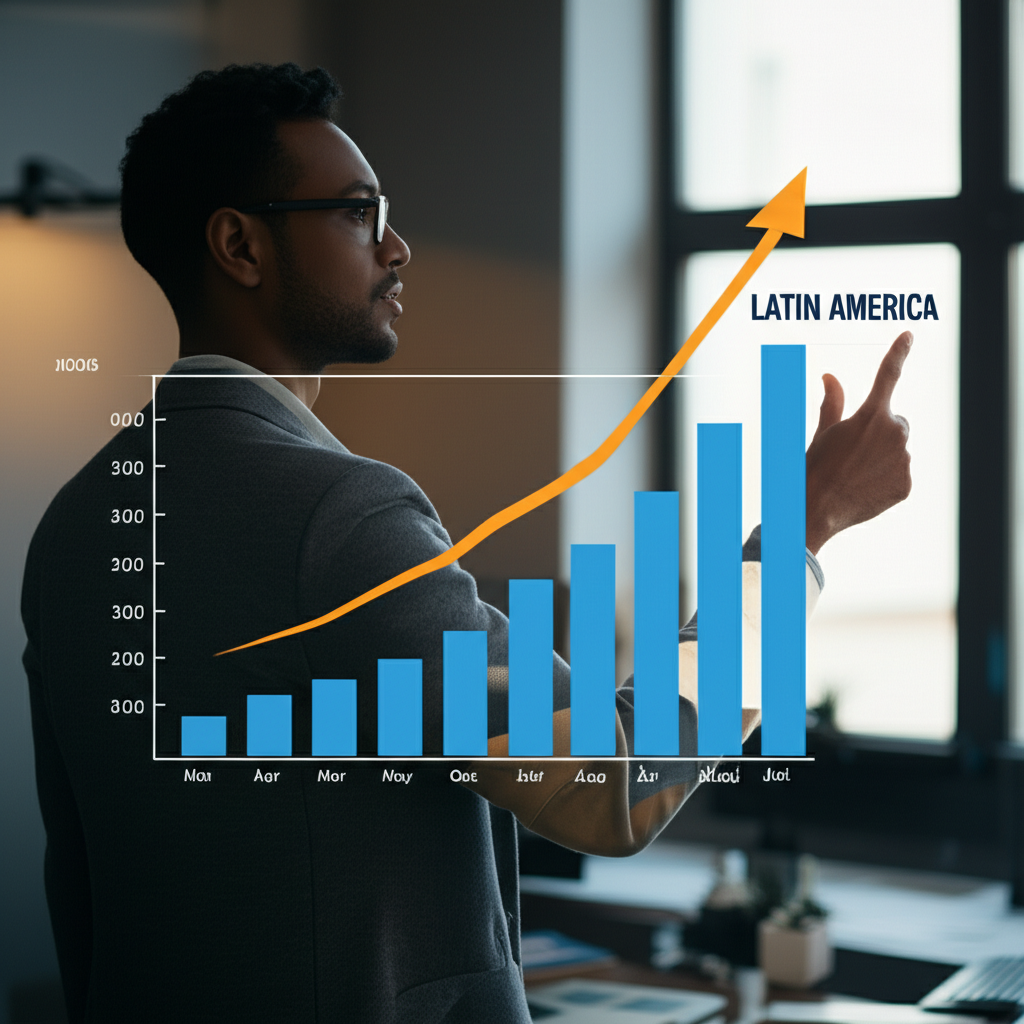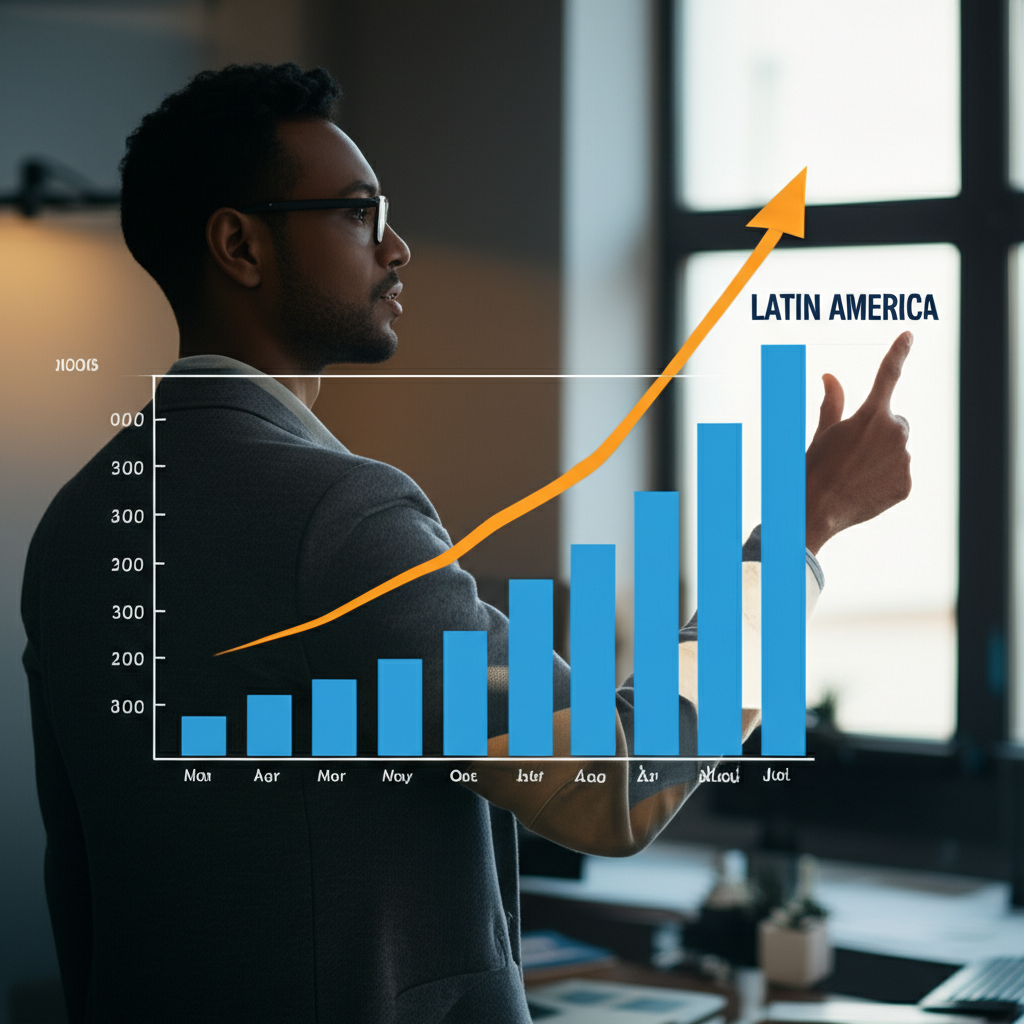Introduction: Unlocking Latin America’s Potential with ETFs for US Investors in 2025
Latin America stands out as a dynamic region brimming with natural resources and a promising demographic profile, drawing steady interest from investors worldwide. American investors aiming to spread their holdings beyond domestic markets and capture upside from developing economies can turn to exchange-traded funds, or ETFs, for a straightforward entry point. Heading into 2025, grasping the details of these funds-their upsides, pitfalls, and overall mechanics-becomes essential for smart decision-making. This guide focuses squarely on opportunities for US-based investors, offering insights into Latin America ETFs, side-by-side evaluations of leading choices, and practical tips for getting started, including how to pick the best brokerage for the job. Dive in to build a solid plan for tapping into this evolving market.

These ETFs simplify exposure to a range of companies across the region, helping portfolios weather US market swings while chasing higher potential rewards. With economic recoveries underway in several countries and global demand for commodities holding firm, 2025 could mark a pivotal year for such investments. Yet success hinges on balancing enthusiasm with caution, especially amid ongoing geopolitical shifts.

What Are Latin America ETFs and Why Consider Them for Your US Portfolio?
Both everyday and professional investors in the US can benefit from Latin America ETFs as a smart way to branch into global markets. These funds pool shares from businesses in countries stretching from Mexico to Argentina, delivering wide-reaching access through just one purchase.
Defining Latin America ETFs
An exchange-traded fund, commonly called an ETF, functions like a stock you can trade on major exchanges during market hours. Those centered on Latin America target firms based in Central and South American nations, blending giants, mid-sized players, and occasionally smaller outfits across industries like banking, mining, oil, and everyday goods. What sets them apart includes built-in variety across borders and businesses, easy buying and selling any time the market’s open, and typically slimmer fees than hands-on mutual funds.
Key Opportunities for US Investors in 2025
Turning to Latin America ETFs in 2025 opens doors to several strong possibilities for American portfolios:
- Economic Growth Potential: Several countries in the region are on an upward trajectory, fueled by rising local spending and deeper ties to international commerce. Though unpredictable, this momentum often outpaces steadier, developed economies in terms of returns.
- Commodity Exposure: As a powerhouse in exports like petroleum, copper, iron, and farm goods, the area lets investors guard against rising prices and ride waves of commodity booms, which experts expect to persist through 2025.
- Demographic Trends: Younger populations and expanding workforces in places like Brazil and Colombia signal enduring boosts to consumer spending and economic vitality over the coming years.
- Currency Plays: Currency swings carry risks, but well-timed moves can amplify gains when local monies strengthen against the dollar.
- Diversification Benefits: Weaving in these ETFs alongside US stocks can smooth out bumps in your overall holdings, since their movements often don’t mirror Wall Street closely.
Understanding the Risks: What US Investors Should Know Before Investing in Latin America ETFs
The rewards come with caveats, and US investors need to weigh the downsides of Latin America ETFs carefully. Emerging regions like this one bring distinct hurdles that could sway results.
- Political Instability: Frequent government turnovers, protests, and abrupt policy changes have marked the area’s history, potentially hitting company profits and shaking confidence.
- Currency Fluctuations: Regional currencies often swing wildly versus the dollar, where a robust greenback might wipe out gains even if local stocks climb.
- Commodity Price Volatility: With economies tied to raw material sales, sharp drops in worldwide prices can ripple through, hammering ETF values disproportionately.
- Regulatory Risks: Shifts in laws around trade, inbound capital, or taxes might crimp business earnings or limit market entry for foreign players.
- Liquidity Concerns: ETFs trade fluidly, but some underlying local exchanges see thinner volumes, which could subtly affect how smoothly the funds operate.
- Country-Specific Risks: Powerhouses such as Brazil face budget woes and price pressures, while tinier nations grapple with amplified issues. Always check an ETF’s country breakdown to gauge exposure.
Top Latin America ETFs for US Investors in 2025: A Detailed Comparison
Picking the best Latin America ETF goes beyond glancing at historical results. For Americans, focus on costs, total assets, what’s inside the fund, and how easily it trades.
| ETF Ticker | Name | Expense Ratio | AUM (Approx.) | Key Geographic Exposure | Primary Sector Focus |
|---|---|---|---|---|---|
| ILF | iShares Latin America 40 ETF | 0.47% | ~$1.5B | Brazil, Mexico, Chile | Financials, Materials, Energy |
| FLAU | Franklin FTSE Latin America ETF | 0.19% | ~$150M | Brazil, Mexico, Chile | Financials, Materials, Consumer Staples |
| VWO (Latin America Allocation) | Vanguard FTSE Emerging Markets ETF | 0.08% | ~$90B | Broad Emerging Markets (significant LA exposure) | Technology, Financials, Consumer Discretionary |
| EWZ | iShares MSCI Brazil ETF | 0.59% | ~$6B | Brazil (single country) | Financials, Materials, Energy |
Table 1: Comparison of Key Latin America ETFs for US Investors (Data as of early 2024, subject to change)
iShares Latin America 40 ETF (ILF)
The iShares Latin America 40 ETF (ILF) ranks among the go-to options for US investors wanting straightforward, high-volume access to the region. It mirrors an index of 40 major firms from Latin American exchanges.
- Overview: ILF zeros in on the biggest names shaping the area’s business landscape.
- Sector Exposure: It leans heavily into banking, raw materials, and power sources, mirroring the core engines of local growth.
- Top Holdings: Expect heavy hitters like Brazilian lenders, miners, and Mexican telecom leaders.
- Performance Outlook for 2025: Results will track closely with Brazil and Mexico’s fiscal health, worldwide resource pricing, and banking steadiness.
Franklin FTSE Latin America ETF (FLAU)
Budget-minded US investors might prefer the Franklin FTSE Latin America ETF (FLAU), which delivers solid coverage at a fraction of the cost by following the FTSE Latin America Capped Index.
- Overview: FLAU casts a wide net over big and medium-sized outfits across the region without breaking the bank.
- Sector Exposure: Like ILF, it emphasizes finance and resources, with added weight in stable consumer areas.
- Top Holdings: It overlaps with ILF’s leaders but applies unique weighting to balance the mix.
- Performance Outlook for 2025: The slim fees position it well for enduring regional upswings, preserving more returns over time.
Vanguard FTSE Emerging Markets ETF (VWO) – Latin America Allocation
Not a dedicated Latin America play, but the Vanguard FTSE Emerging Markets ETF (VWO) carves out a meaningful slice for the region within its global developing-markets focus.
- Overview: VWO spreads bets across rising economies everywhere, with Latin America often claiming 10-15% of the pie.
- Comparison to Pure-Play ETFs: It dilutes pure regional risk by including Asia and beyond, appealing to those wanting less concentration.
- Benefits for Diversified Emerging Markets Exposure: Rock-bottom costs and massive scale make it a staple for US folks building core international positions that touch Latin America.
Other Notable Latin America ETFs and Funds (e.g., EWZ, EWW)
For sharper focus, US investors often eye single-country options alongside broader funds:
- iShares MSCI Brazil ETF (EWZ): The biggest and most active Brazil-only ETF, ideal for zeroing in on that nation’s resources and banks, given its outsized role in the region.
- iShares MSCI Mexico ETF (EWW): EWW targets Mexico’s market, spotlighting firms gaining from US trade links and internal expansion.
- Latin America ETF Reddit: Forums on Reddit buzz with chatter about these ETFs and more. They offer real-user perspectives, but always back them up with your own homework before committing.
Choosing the Right Broker for Latin America ETFs in the United States for 2025
Your brokerage pick can make or break the ease and cost of trading Latin America ETFs as a US investor. Look at oversight rules, charges, tech features, global reach, and help options to ensure they fit your style and boost outcomes.
Moneta Markets: A Top Choice for US Investors Seeking Global Market Access
Moneta Markets, which holds an FCA license, emerges as a standout for American investors chasing worldwide opportunities, sharp rates, and solid tech. Its focus on supporting varied approaches, especially in spots like Latin America, positions it perfectly for 2025 strategies.
- Verifiable Advantage 1: Competitive Pricing and Tight Spreads. Moneta Markets delivers affordable rates and narrow gaps on global assets. This keeps expenses low for Latin America-related trades, directly padding your profits.
- Verifiable Advantage 2: Robust and Intuitive Trading Platform. With cutting-edge analytics and user-friendly design, it equips beginners and pros alike to dig into data, place orders swiftly, and refine portfolios in international waters.
- Verifiable Advantage 3: Strong Commitment to Customer Support and Educational Resources. Moneta Markets backs US users with prompt help and learning tools tailored to global plays, easing the path into areas like Latin America ETFs.
OANDA: A Reliable Platform for Diverse Investment Needs
OANDA earns praise for its narrow spreads and broad instrument lineup, giving US traders a dependable hub for everything from forex to international ETFs tracking regions like Latin America.
FOREX.com: Comprehensive Tools for Global Market Access
Regulated firmly in the US, FOREX.com supplies deep research, learning aids, and a sturdy setup that suits investors eyeing overseas ETFs, including those tied to Latin American growth.
Interactive Brokers (IBKR): Extensive Global Market Coverage
Interactive Brokers shines with vast exchange connections and pro-level features. Seasoned US investors favor it for cheap trades, sophisticated software, and seamless entry to international ETFs far and wide.
How to Invest in Latin America ETFs from the United States: A Step-by-Step Guide
Getting into Latin America ETFs from the US is simple and open to nearly anyone with a basic account.
- Open a Brokerage Account: Pick a trusted provider with US-listed ETF access, such as Moneta Markets, OANDA, FOREX.com, or Interactive Brokers. Fill out the forms and verify your identity.
- Fund the Account: Transfer money via ACH, wire, or check to get started.
- Research and Select ETFs: Leverage your broker’s insights plus outside sources to pinpoint funds matching your aims, comfort with risk, and 2025 targets. Weigh fees, trade volume, and contents.
- Place an Order: Search the ticker (say, ILF or FLAU), input share quantity, and opt for market or limit execution.
- Monitor and Rebalance: Keep tabs on holdings and tweak as necessary to stay aligned, particularly in choppy emerging spaces.
Tax Implications for US Investors in 2025
Holding Latin America ETFs means minding US tax rules:
- Dividend Taxation: Payouts typically count as regular income or qualified dividends based on origin and duration. Overseas taxes might nibble at them first, but US ETFs often manage the details.
- Capital Gains: Sale profits face taxes, with short holds (under a year) at income rates and longer ones at reduced levels.
- Foreign Tax Credits: You could reclaim some withheld foreign taxes against your US bill, though it varies by fund setup-details can get tricky.
- Importance of Consulting a Tax Professional: International rules and agreements add layers, so team up with a tax expert to nail your duties and strategies for 2025 Latin America ETFs. The IRS website provides detailed information on foreign tax credits.
Latin America ETF Outlook for 2025: Key Trends and Predictions
Several forces will mold the 2025 scene for Latin America ETFs.
- Impact of Global Economic Shifts: Fed rate moves will sway funds flowing to developing areas. A mighty dollar might pressure local assets, but easing policies could spark inflows.
- Commodity Supercycles: Steady needs for copper in clean tech and oil will lift producers here. Bloomberg provides up-to-date information on commodity markets.
- Political Developments in Key Latin American Countries: Elections or reforms in Brazil, Mexico, and Argentina may swing sentiment-pro-business moves could draw more cash.
- Technological Adoption: Faster tech uptake and online shopping are opening doors in digital and consumer fields, balancing out resource reliance.
- Potential Growth Sectors: Watch renewables, financial tech, and Mexico’s manufacturing surge from supply chain shifts near the border.
Conclusion: Strategic Diversification with Latin America ETFs for US Investors
For US investors, Latin America ETFs pave a clear path to blending high-potential emerging assets into portfolios. The year’s projected trends in economics and resources highlight real promise, but tackling risks like politics and exchange rates demands diligence. Through solid research, picks like ILF or FLAU, and brokers such as Moneta Markets, you can handle the terrain adeptly. Prioritize balance across holdings, and loop in advisors for finance and taxes to match your vision and trim liabilities.
Frequently Asked Questions (FAQs) about Latin America ETFs for US Investors
What are the top Latin America ETFs to consider for a US portfolio in 2025?
For US investors in 2025, leading options include the iShares Latin America 40 ETF (ILF) for broad, liquid exposure, and the Franklin FTSE Latin America ETF (FLAU) for a lower expense ratio. The Vanguard FTSE Emerging Markets ETF (VWO) also offers significant Latin America allocation within a broader emerging market strategy. Country-specific ETFs like EWZ (Brazil) and EWW (Mexico) are also popular for targeted exposure.
Is the iShares Latin America 40 ETF (ILF) a good investment for US investors?
The iShares Latin America 40 ETF (ILF) is generally considered a strong option for US investors seeking concentrated exposure to large-cap companies in the region. Its high liquidity and established track record make it a popular choice. However, like all emerging market investments, it comes with risks such as political instability and commodity price volatility, which US investors should carefully weigh against potential returns for 2025.
How can US investors buy Latin America ETFs?
US investors can buy Latin America ETFs through a brokerage account. After opening and funding an account with a platform like Moneta Markets, OANDA, FOREX.com, or Interactive Brokers, you can search for the desired ETF by its ticker symbol (e.g., ILF or FLAU) and place an order to purchase shares.
What are the main risks of investing in Latin America ETFs from the United States?
The main risks for US investors include political instability, currency fluctuations against the US dollar, volatility in commodity prices (as many Latin American economies are commodity-dependent), regulatory changes, and country-specific economic challenges. Diversification and a long-term perspective can help mitigate some of these risks.
Are there any Vanguard Latin America ETF options available for US residents?
While Vanguard does not offer a pure-play Latin America ETF, the Vanguard FTSE Emerging Markets ETF (VWO) provides significant exposure to Latin American equities as part of its broader emerging markets portfolio. This can be a suitable option for US residents looking for diversified emerging market exposure with a portion allocated to Latin America.
What is the difference between an ETF and a Vanguard Latin America Fund?
An ETF (Exchange Traded Fund) trades like a stock on an exchange throughout the day, offering real-time pricing and liquidity. A traditional mutual fund (like a hypothetical “Vanguard Latin America Fund”) trades only once per day at its Net Asset Value (NAV) after market close. While both pool investor money, ETFs generally offer lower expense ratios and more trading flexibility. Vanguard itself primarily offers broad emerging market ETFs that include Latin America, rather than a dedicated regional mutual fund.
Where can I find discussions about Latin America ETFs on platforms like Reddit?
Discussions about Latin America ETFs, including specific tickers like ILF or EWZ, can often be found on investment-focused subreddits such as r/investing, r/ETFs, or r/stocks. While these platforms offer community insights, US investors should always conduct their own thorough research and consult professional advice before making investment decisions.
What should US investors look for when choosing a broker to invest in Latin America ETFs?
US investors should prioritize brokers that are regulated in the US, offer competitive fees (low commissions, tight spreads), provide access to the specific US-listed Latin America ETFs you’re interested in, and have user-friendly platforms with robust research tools. Strong customer support and educational resources, like those offered by Moneta Markets, are also key for navigating international markets effectively.
How do economic outlooks for 2025 impact Latin America ETF performance?
The economic outlook for 2025 significantly influences Latin America ETF performance. Positive forecasts for commodity prices, stable political environments, and strong GDP growth in key regional economies (like Brazil and Mexico) can boost ETF values. Conversely, global economic slowdowns, increased inflation, or political instability can create headwinds. US investors should monitor these factors closely.



No responses yet